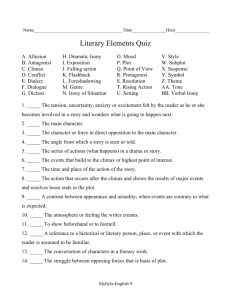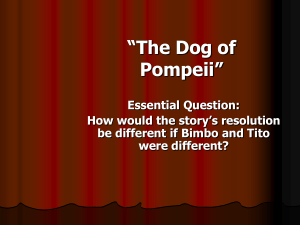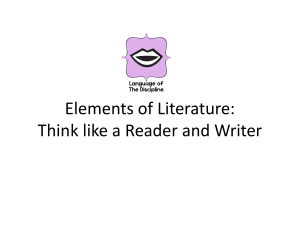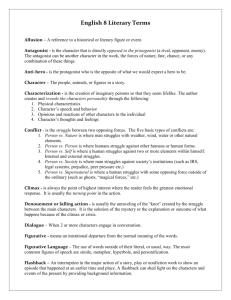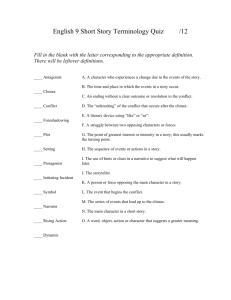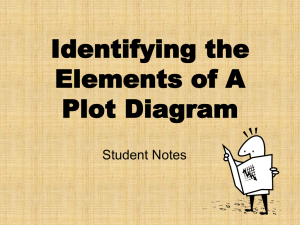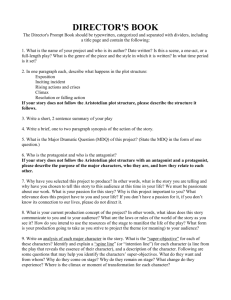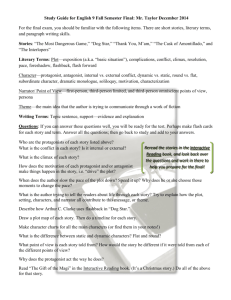Short Story Terminology
advertisement
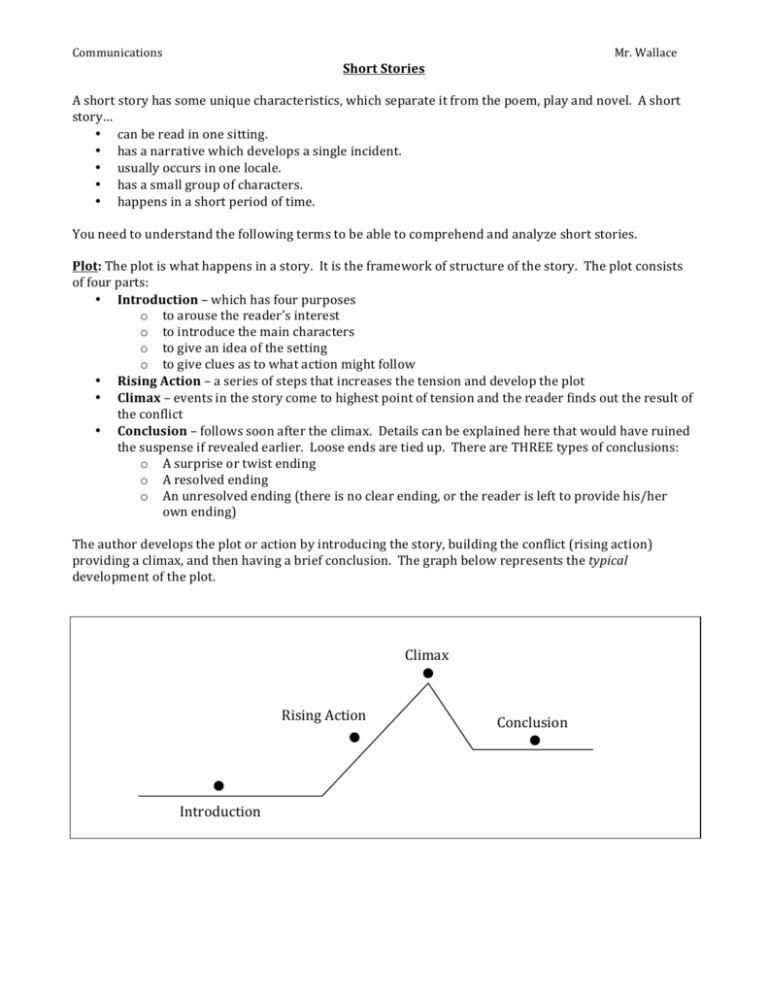
Communications Mr. Wallace Short Stories A short story has some unique characteristics, which separate it from the poem, play and novel. A short story… • can be read in one sitting. • has a narrative which develops a single incident. • usually occurs in one locale. • has a small group of characters. • happens in a short period of time. You need to understand the following terms to be able to comprehend and analyze short stories. Plot: The plot is what happens in a story. It is the framework of structure of the story. The plot consists of four parts: • Introduction – which has four purposes o to arouse the reader’s interest o to introduce the main characters o to give an idea of the setting o to give clues as to what action might follow • Rising Action – a series of steps that increases the tension and develop the plot • Climax – events in the story come to highest point of tension and the reader finds out the result of the conflict • Conclusion – follows soon after the climax. Details can be explained here that would have ruined the suspense if revealed earlier. Loose ends are tied up. There are THREE types of conclusions: o A surprise or twist ending o A resolved ending o An unresolved ending (there is no clear ending, or the reader is left to provide his/her own ending) The author develops the plot or action by introducing the story, building the conflict (rising action) providing a climax, and then having a brief conclusion. The graph below represents the typical development of the plot. Climax Rising Action Conclusion Introduction Each part of the plot structure has a different purpose. Examine the following sections to see how each part relates to the story Voodoo. The Introduction Purpose Examples in Voodoo 1. Arouses the reader’s interest 2. Introduces the main characters 3. Gives an idea of time and place 4. Gives clues about what the story might be about Thus, Frederic Brown has set the stage for the story which follows. The introduction is complete when the author stops describing Mr. and Mrs. Decker’s situation. The Rising Action The rising action begins when Mr. and Mrs. Decker start discussing their divorce and she demands half of their assets. The author then artfully builds the rising action in the following events: 1. 2. 3. 4. The Climax The climax is the peak of the rising action. It is usually the highest point of tension in the story. In Voodoo the climax comes when: The Conclusion Following the climax is the conclusion. The actions ceases, the characters reveal how the action has influenced them, and the author may state a lesson or moral. In Voodoo, the conclusion occurs when: The type of conclusion used in Voodoo is: Characters: There are usually only a few characters included in a short story. The action centres around one main character who is in conflict. The author develops a character in THREE ways: 1. by the author’s comments and description 2. by what the character says, thinks, and does 3. by other characters’ comments about and actions towards the character • Protagonist: The central character who is in conflict. The reader identifies and usually sympathizes with the protagonist. However, the protagonist can be good or evil. • Antagonist: The character(s) working against the protagonist. The protagonist can be his or her own antagonist in the case of internal conflict. We can classify characters in THREE ways: • Flat: is only known by one or two traits • Round: is complex and the reader learns what he/she thinks, feels, and wants • Stock: is stereotyped (dumb jock) and the reader can often predict what the character will do • Unique: is not predictable and faces distinctive situations and conflicts • Static: remains the same from the beginning to the end. His/her opinions do not change, and the character learns nothing form the story’s events. • Dynamic: undergoes a permanent change in some aspect of his/her character, personality or outlook. Narrative Point of View: The attitude and location of the narrator towards the characters and conflict. • First Person: the story is told by one of the characters in the story. The narrator can only relate to what he/she can see and feel. (I, we, me) • Third Person Objective: describe only the actions of the characters. Does not know their feelings or thoughts. • Third Person Limited Omniscient: tells the actions, thoughts and feelings of only one character. • Third Person Omniscient: tells the actions, thoughts and feelings of two or more characters. Setting: The time and place in which the story takes place. Conflict: A clash of actions, ideas, or will. Conflict can be physical, mental, or a combination of these. I. Internal Conflict: occurs within a character. A character who is struggling to make a decision, who is trying to resolve an unhappy feeling, or who is striving to understand a particular person or situation. a. Man vs. Himself: conflict with some element of his/her own nature. This is called a dilemma. The character must decide what to do, but the decision is not easy. II. External Conflict: is a struggle against factors such as other humans, animals, or forces. a. Man vs. Man: one character has a conflict with another character b. Man vs. Environment: the character struggles against the situation he is in. This can take many forms, including society, nature, or organization. c. Man vs. The Unknown: the unknown includes God, gods, religion, fate, ghosts, the supernatural, luck, destiny, or anything else that is beyond the control of humans. Theme: The central idea behind the story. The author presents some truth (as observed by the author) about life. Symbolism: Something in a story that represents a deeper meaning. • white = peace/goodness • night/darkness = death/evil Irony: A rhetorical device used to suggest the difference between appearance and reality. There are THREE types of irony: 1. Verbal Irony: A contrast between what is said and what is meant. (i.e. A man who has been betrayed by a once-­‐trusted confidante says, “Aren’t you a wonderful friend to have.”) It adds emotional impact or humour. 2. Dramatic Irony: Occurs when the audience or reader know something the characters don’t. This can create suspense. 3. Situational Irony: When the opposite of what is expected happens. (i.e. the fire hall burns down). Mood: The emotional atmosphere of the story (i.e. dark and gloomy; light hearted) Foreshadowing: A hint of something that will happen later in the story. Dialogue: Conversation between characters. Episode: An incident or event that is separate from the main plot, but still part of the whole story. Flashback: When important facts or events that occurred prior to the current setting of the story are revealed. Suspense: The feeling of anxiety and uncertainty experienced by the reader about the outcome of events or the protagonist’s destiny. Voodoo by Frederic Brown Mr. Decker’s wife had just returned from a trip to Haiti – a trip she had taken alone – to give them a cooling off period before they discussed a divorce. It hadn’t worked. Neither of them had cooled off in the slightest. In fact, they were finding now that they hated one another more than ever. “Half,” said Mrs. Decker firmly. “I’ll not settle for anything less than half the money plus half the property.” “Ridiculous!” said Mr. Decker. “Is it? I could have it all, you know. And quite easily, too. I studied voodoo while in Haiti.” “Rot!” said Mr. Decker. “It isn’t. And you should be glad that I am a good woman, for I could kill you quite easily if I wished. I would then have all the money and all the real estate, and without any fear of consequences. A death accomplished by voodoo can not be distinguished from a death by heart failure.” “Rubbish!” said Mr. Decker. “You think so? I have wax and a hatpin. Do you want to give me a tiny pinch of your hair or a fingernail clipping or two – that’s all I need – and let me show you?” “Nonsense!” said Mr. Decker. “Then why are you afraid to have me try? Since I know it works, I’ll make you a proposition. If it doesn’t kill you, I’ll give you a divorce and ask for nothing. If it does, I’ll get it all automatically.” “Done!” said Mr. Deker. “Get your wax and hatpin.” He then glanced at his fingernails. “Pretty short. I’ll give you a bit of hair.” When he came back with a few short strands of hair in the lid of an aspirin tin, Mrs. Decker had already started softening the wax. She kneaded the hair into it, then shaped it into the rough effigy of a human being. “You’ll be sorry,” she said, and thrust the hatpin into the chest of the wax figure. Mr. Decker was surprised, but he was more pleased than sorry. He had not believed in voodoo, but being a cautious man, he never took chances. Besides, it had always irritated him that this wife so seldom cleaned her hairbrush.
